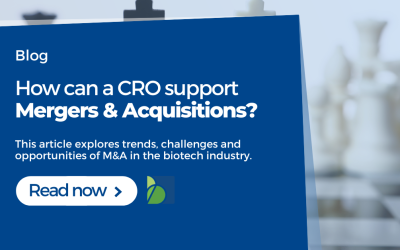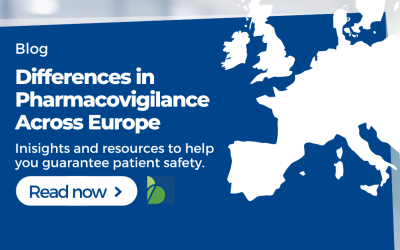Automation & AI in Pharmacovigilance: Promises and Realistic Expectations
Recent years have seen increasing pharmaceutical companies’ pharmacovigilance (PV)-related activities. The promise of artificial intelligence (AI) and automation is often mentioned as a way to meet the increasing PV demands and as a way to curb its corresponding costs. Indeed, automation has become a standard practice for some aspects of most PV systems, but a fully automated PV process is still far from reality. This article first discusses the causes of the increasing PV demands. Then we describe the technical possibilities of cognitive computational solutions and focus on which aspects of PV they can automate or assist.
What are pharmacovigilance activities?
PV is the continuation of collecting safety data about a medicinal product after market authorization. In this stage, a medicinal product is used by a bigger and more diverse group of patients or individuals, which can lead to the detection of side effects that were not detected during (pre-)clinical trials. The WHO defines pharmacovigilance, or drug safety, as the science and activities related to detecting, assessing, understanding, and preventing adverse effects or any other possible drug-related problems. For this purpose, data about Adverse Events (AEs), medication errors and counterfeit products are collected. To harmonize data from different sources, it is coded according to standards like the ICH’s MeDRA dictionary (Medical Dictionary for Regulatory Activities). Subsequently, the causal link with the medicinal product and the seriousness is assessed and analyzed, where you can take actions such as updating drug labels or reporting to competent authorities. Processing of AE data normally takes place within a safety database.
PV activities typically consist of two broad categories: the processing of individual AE reports, also called Individual Case Safety Reports (ICSRs), and safety signal management or post-market surveillance (PMS). Safety signal management usually comprises multiple reports of AEs. It is focused on determining whether they are Adverse Drug Reactions (ADRs), i.e. whether there is a causal link with the medicinal product. It involves sources like ICSRs, clinical trial data, medical literature, health databases and real-world data (e.g. electronic health records (EHRs), insurance claims, surveys and social media sources). The evaluation and validation of these data can have implications for the drug’s safety profile. Processing of ICSRs is the most labour-intensive PV activity, with a lot of repetitive tasks. It is therefore also the most costly activity, taking up between 40 and 85% of the PV budget of a pharmaceutical company.
Increasing Pharmaacovigilance activities
The increase in PV activities in recent years has several causes. First of all, the ageing population in the biggest global pharmaceutical markets results in people suffering from more, and more, complex health problems while also using more medicines. This results in an increased reporting of health issues, regardless of whether there is a causal link to the use of medicinal products. This is tied to pharmaceutical companies’ product portfolios becoming increasingly complex, requiring careful post-market surveillance of medicinal products. Moreover, regulatory bodies are increasing the requirements for PV, for instance, by demanding the inclusion of new data sources. Especially the increasing volume of Real-World Data and new data sources like wearables and social media are putting a growing strain on PV activities.
Furthermore, there is an increased engagement from the public to report AEs, as well as increased demand for the highest possible level of drug safety and post-market surveillance. Pharmaceutical companies are therefore looking for ways of meeting these demands while also improving the cost-efficiency of PV activities. Luckily, developments in cognitive computation and automation make it possible to increase the volume of data sources in PV, improve data analysis possibilities and reduce the manual labour involved and, thereby costs.
Developments in Automation, Cognitive Computing & Artificial Intelligence
When it comes to automation, terms like artificial intelligence, machine learning and neural learning are often used together and sometimes interchangeably, even though they are technically different. It is therefore suitable to provide a short overview of often-used terms related to automation in PV:
- Artificial intelligence (AI) is the theory and development of computer systems that are capable of performing tasks that normally require human intelligence. This involves like visual perception, speech recognition, reasoning and decision-making.
- Machine learning (ML) is the training and adaptation of software algorithms and statistical models to analyze and draw inferences from patterns in data. After using so called training datasets, an algorithm can be taught to look for patterns in data, and detect data points of interest. Automation in PV is mostly based on machine learning.
- Neural networks are computer systems organized in multiple layers, mimicking the organization of neurons in the brain, and thereby achieving a high computation power.
- Deep learning or neural learning is an advanced form of machine learning. Multi-layered artificial neural networks are used to determine multiple patterns in a dataset, extracting high-level features from the data.
- Natural language processing (NLP) refers to the processing and analysis of large amounts of natural language data, usually in unstructured text forms. It can, for instance, be used to detect keywords in a text.
- Natural language generation (NLG) is the production of human language data, usually in unstructured text form.
Possibilities for automation in pharmacovigilance
It has been estimated that up to 70% of PV activities can be automated. We can make the most gains in case processing. We can use ML and NLP algorithms to detect and extract AEs from unstructured data. This can, for instance, be done by using NLP algorithms to scan text files from news articles, social media sources, and medical records for specific keywords. Automated screening of medical literature is also possible with NLP algorithms. This can, for instance, be used for selecting relevant articles and removing redundant information in articles, thereby significantly improving the screening time for a PV specialist. Foreign text data sources can be automatically translated to enable use in the PV assessment.
ML can also be used for duplicate checking, checking for missing data and case validity assessment. Furthermore, it is used for classifying and coding ICSRs in the safety database. An algorithm uses a standardized procedure to perform these processes instead of the variability in assessment from PV specialists. Therefore, the data quality will likely improve with increased accuracy and consistency. The processing speed is also higher in automated and manual processes.
AI can assist quality review and causality assessment by analyzing the context of ADRs and the frequency of similar reports. A PV specialist will, however, still have to make the ultimate assessment during these processes.
Using big-data analytics, data from various sources (clinical trials, EHRs, medical literature, real-world data, PV databases etc.) can be combined and analyzed in an earlier stage. Furthermore, data can also be extrapolated and used for predictive signalling. This is useful for the visualization of this data and can enable intermediary assessments. This can lead to earlier detection of ADRs or safety signals, thereby allowing for action to be taken at an earlier stage and thus increasing patient safety.
NLG-based automation of filling-in reports in the safety database, or reports that have to be submitted to authorities, can reduce the time spent on reporting and can increase compliance with regulatory standards.
Although these developments sound very promising and deliver accurate results, the accuracy is not always 100%. It has been shown that automation in PV is highly accurate for coding and validation. The accuracy of detecting AEs from various sources is high but can still be improved. Moreover, the translation of foreign-language sources is helpful but far from perfect. We should therefore keep in mind that the role of automation in PV depends on each step in the PV process. Some aspects can (almost) be fully automated, whereas for others, automation should be considered a tool to assist the manual tasks performed by a PV specialist.
For these reasons, the EMA is also developing regulation guidelines regarding the use of AI in PV. This is related to, for example, allowing a risk-based approach of using AI in PV and setting requirements to the types of data sources we should include, but also applying the GDPR privacy regulation to automated PV software.
All in all, the advances in PV automation lead to decreased PV activities costs and an increase in efficiency. Moreover, it saves PV experts a lot of time on repetitive tasks and frees resources for more complicated tasks like safety signal management and benefit-risk analyses.
How can a CRO support Mergers & Acquisition
The role of Contract Research Organizations (CROs) in supporting mergers and acquisitions (M&As) is not a new concept, as CROs have been providing services in this area for several years. However, the demand for these services may have increased in recent years...
National differences for Pharmacovigilance in Europe
Join our webinar on “Navigating National Differences in Setting up a Pharmacovigilance System in Europe.” 🇪🇺 💊
National Differences in Pharmacovigilance Requirements in Europe
Pharmacovigilance requirements in Europe are primarily governed by the European Medicines Agency (EMA) through the EU Regulation on Pharmacovigilance (Regulation (EU) No 1235/2010). However, some national differences in implementing and enforcing these requirements...








